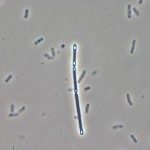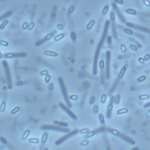Link to Pubmed [PMID] – 9622354
Mol. Microbiol. 1998 Apr;28(2):293-303
LevR, which controls the expression of the levoperon of Bacillus subtilis, is a regulatory protein containing an N-terminal domain similar to the NifA/NtrC transcriptional activator family and a C-terminal domain similar to the regulatory part of bacterial anti-terminators, such as BgIG and LicT. Here, we demonstrate that the activity of LevR is regulated by two phosphoenolpyruvate (PEP)-dependent phosphorylation reactions catalysed by the phosphotransferase system (PTS), a transport system for sugars, polyols and other sugar derivatives. The two general components of the PTS, enzyme I and HPr, and the two soluble, sugar-specific proteins of the lev-PTS, LevD and LevE, form a signal transduction chain allowing the PEP-dependent phosphorylation of LevR, presumably at His-869. This phosphorylation seems to inhibit LevR activity and probably regulates the induction of the lev operon. Mutants in which His-869 of LevR has been replaced with a non-phosphorylatable alanine residue exhibited constitutive expression from the lev promoter, as do levD or levE mutants. In contrast, PEP-dependent phosphorylation of LevR in the presence of only the general components of the PTS, enzyme I and HPr, regulates LevR activity positively. This phosphorylation most probably occurs at His-585. Mutants in which His-585 has been replaced with an alanine had lost stimulation of LevR activity and PEP-dependent phosphorylation by enzyme I and HPr. This second phosphorylation of LevR at His-585 is presumed to play a role in carbon catabolite repression.

